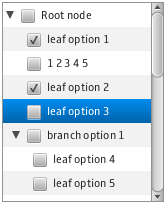FX Experience Has Gone Read-Only
I've been maintaining FX Experience for a really long time now, and I love hearing from people who enjoy my weekly links roundup. One thing I've noticed recently is that maintaining two sites (FX Experience and JonathanGiles.net) takes more time than ideal, and splits the audience up. Therefore, FX Experience will become read-only for new blog posts, but weekly posts will continue to be published on JonathanGiles.net. If you follow @FXExperience on Twitter, I suggest you also follow @JonathanGiles. This is not the end - just a consolidation of my online presence to make my life a little easier!
tl;dr: Follow me on Twitter and check for the latest news on JonathanGiles.net.
by Jonathan Giles | Jul 4, 2010 | Links
Wow, July already. Time sure is flying these days. As always, please feel free to flick me an email or a tweet to let me know of any news you want included. Let’s get on with the news!
- Tor Norbye blogged about not using implicit return types in public API declarations in JavaFX, and from my perspective, copped quite an unfair bashing for doing so. He also provided a NetBeans plugin for identifying this issue, and ‘quick fixing’ it. As for the comments on the post: I personally love implicit typing, but not when it is public API, for the reasons Tor identifies. It would suck to have to type :Void for every function and specify the type of all parameters in an overridden function. The language really isn’t broken.
- The Exadel JavaFX Plugin for Eclipse has been upgraded to 1.3.3. In addition to this they’ve blogged about the new ‘go to member’ feature added in 1.3.3.
- Johannes Schneider has announced that he has added his JavaFX2Java bridge to the JFXtras project (in a separate cloned repo). You can find out more about this bridge in another blog posting.
- The Oracle Technical Network interviewed John Jullion-Ceccarelli and Martin Ryzl, two of the managers behind NetBeans 6.9. They discussed the new NetBeans Composer tool for rapid JavaFX application development.
- Srikanth Shenoy has blogged about ‘Effective JavaFX Architecture‘. This is the first part of a series of posts he is promising to do.
- Eviware popped out of nowhere this week with their loadUI application for load-testing webapps. They’ve posted some videos and in general their app, built using JavaFX and Groovy, looks really impressive.
- Oracle announced that JavaFX is powering the Major League Baseball ‘fantasy baseball’ applications, although I haven’t yet seen it in action because I don’t live in the US or Canada (but you can go here to sign up, and presumably play).
That’s it for another week folks. Catch you in a weeks time.
by Jonathan Giles | Jun 27, 2010 | Links
A fairly quiet week in the JavaFX world this week, but nevermind, I’m sure it’s just because the majority of you are too busy working on your blog masterpieces for next week 🙂 Regardless, there are some very useful links in this weeks post, so have at it, and as always please do flick me an email (or twitter message) with any link you think is worthy of being included.
That’s all folks. Thanks to everyone who took the time to post about what they’re working on, and for those of you who didn’t, I’m looking forward to your blogging masterpieces next week 🙂

by Jonathan Giles | Jun 26, 2010 | Controls, Performance, UI Design
Ok, I know we’ve been going on about custom cells / cell factories a bit recently, but I wanted to do one more post about a very useful topic: caching within cell content.
These days ‘Hello World’ has been replaced by building a Twitter client, so I’ve decided to frame this topic in terms of building a Twitter client. Because I don’t actually care about the whole web service side of thing, I’ve neglected to implement the whole ‘real data’ / web services aspect of it. If you want to see an actual running implementation with real data, have a look at William Antônio’s Twitter client, which is using this ListCell implementation.
(more…)
by Jonathan Giles | Jun 25, 2010 | Links
Recently a few useful documents turned up on the web related to JavaFX, so I thought I’d briefly provide the links to them in case you weren’t aware of their existence.
Firstly, the JavaFX team updated the JavaFX 1.3 API documentation. There is a bunch of new content for much of the API, and improved package documentation (which you can see by clicking the arrow on the main page relevant to the package you’re interested in). In particular, the javafx.animation, javafx.scene, javafx.scene.control and javafx.scene.chart packages have a bunch of useful information.
Secondly, with the huge improvements to CSS support in JavaFX 1.3, we’ve published a comprehensive CSS guide. This is a huge resource to people interested in styling JavaFX user interfaces, as it lists all available css properties for each control.
Finally, for those interested in ensuring your coding style is following convention, the best resource is Tor Norbye’s JavaFX coding conventions document. It’s not the definitive style guide for JavaFX, but it is a great starting point. I think there is only one difference between his conventions and what we use internally, and he notes this in the page.
There we go – a few very useful resources that you may be interested in perusing in a spare moment.
by Jonathan Giles | Jun 20, 2010 | Links
Welcome to another week of JavaFX links folks. This week there is a good bunch of interesting news and blog posts, so I hope that there is something here for everyone. As always feel free t get in touch with me if you have a link you’d like to have included.
That’s us for another week. Keep churning out the good posts and news and I’ll keep linking to you. Catch you all in a weeks time.

by Jonathan Giles | Jun 17, 2010 | Controls
Yuck, ‘CheckBoxTreeView’ – what a mouthful. Anywho – I was just looking at a very interesting JavaFX session slidedeck from Jazoon presented by AdNovum Informatik AG titled ‘JavaFX – The Condemned Live Longer‘. It is a great slide deck as they are a company that have invested a lot of time researching the available RIA technologies, and they are pretty upfront with what they like and don’t like in JavaFX, and what their developer experience has been.
(more…)
by Jonathan Giles | Jun 13, 2010 | Links
A quieter week this week for some reason, but nonetheless some interesting links are to be had. Keep up the good work folks – it’s great to read what’s going on in the community.
That’s all folks! Catch you all again in a weeks time, and as always feel free to flick me an email, a tweet, or whatever else floats your boat.
by Jonathan Giles | Jun 6, 2010 | Links
Another week, another bunch of links. It seems like you lot have been very busy! 🙂
- We introduced two new preview controls in JavaFX 1.3: MenuButton and SplitMenuButton. We also implored you to read Amy Fowler’s recent blog posts on layout in JavaFX 1.3. Finally, we gave the site a bit of a spit-shine, with more visual tweaks to come in the next few weeks – what’ya think?
- The JavaFX docs team have put together a huge article on ‘Tips for developing on the JavaFX TV platform‘.
- Jim Weaver has posted a BorderLayout container that he built as an example of how it is possible to build custom layouts in JavaFX.
- Rastislav Komara has posted about a new feature in NetBeans Composer in the 6.9 RC1 release: grid container support. Note that NetBeans 6.9 RC2 was also released this week.
- Speaking of NetBeans Composer, Antoine Mischler has blogged his thoughts about it, as has Nick Apperbly.
- Stephen Chin has posted his Jazoon slide deck for his recent talk which was titled ‘Building Data Rich Interfaces with JavaFX‘.
- Also related to Stephen is the announcement that the Apropos project has been open sourced. This is an ‘Agile Project Portfolio Scheduler’ written in JavaFX.
- Mikhail Gorshenev has been posting a bunch of JavaFX TV posts recently. They are titled ‘3D Scene Support in JavaFX TV‘, ‘TV-Friendly Focus Traversal‘, ‘Simple CSS Styling‘ and ‘3D Carousel‘.
- Speaking of Mikhail, he is presenting at the Silicon Valley JavaFX Users Group this week. His presentation is called ‘Top Secret JavaFX TV Preview‘. The presentation is on June 9 at 6:00pm PST, at the Oracle Conference Center.
- Osvaldo Doederlein continued his research into the JavaFX scenegraph by continuing the development of his JavaFX Game of Life implementation. Fortunately this week he has more positive things to say about the scenegraph 🙂
- Rakesh Menon, who recently left Oracle to join Cisco, has posted his JavaFX Wish List. All I can say with regard to his wish list is that I know we’re working on improvements to many of his comments!
- Antoine Mischler has blogged about using inversion of control in a JavaFX application.
As always thanks to everyone for the hard work you do, and an extra round of thanks for blogging about it so that we can all learn from your experiences. As always you can email me or find me on twitter if you want to chat. You should also follow the @fxexperience twitter account to be informed of new posts to this site. Until next week – keep up the good work folks! 🙂

by Jonathan Giles | Jun 2, 2010 | Controls

The MenuButton and SplitMenuButton controls
We recently discussed the new preview Menu control that is part of JavaFX 1.3. Another part of this release is a number of controls that make use of menus internally, and this post talks about two new preview controls that do just this: MenuButton and SplitMenuButton. (more…)
by Jonathan Giles | May 30, 2010 | Layout, Links
Building decent-sized applications requires layouts (unless you like pain), and the funny thing about layouts is that they’re tough…..real tough……until you bother to actually understand them. The second funny thing about layouts is that once you do understand them they’re simple and powerful. An added bonus is that your head stops hurting and your curse-words jar becomes considerably less overflowing. Finally, your children/partner/pet/pet-rock will love you more and the world will become a happier, more smiley place. This is the power of understanding layouts.
So, please, if you don’t know how to use the JavaFX layout containers, go and read Amy Fowler’s new blog. It is starting off with a bang, covering what’s new and changed in JavaFX 1.3 – and it’s well worth your time to read it. Keep reading each post until it makes sense. If you go cross-eyed or consider giving up, you’re doing yourself an injustice. Read it again!
For convenience, here’s the links you’ll want to read:
Now, go forth and read! 🙂


